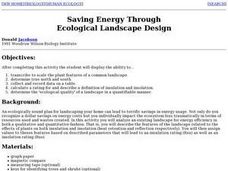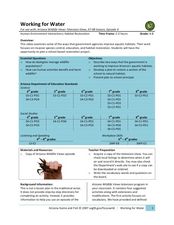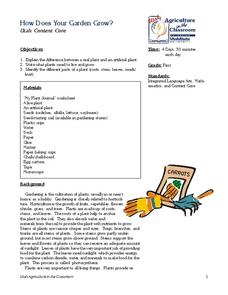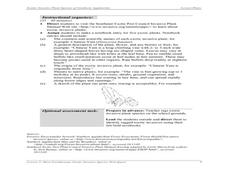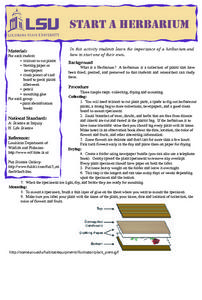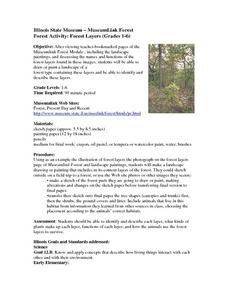Curated OER
Saving Energy Through Ecological Landscape Design
Learners are able to transcribe to scale the plant features of a common landscape. They determine true north and south and collect and record data on a table. Students calculate a rating for and describe a definition of insulation and...
Curated OER
Wetland Adaptation
Fourth graders study the impact of the wetland environment on the migration of birds. They make a list of the important reasons on a large piece of paper to be posted in the classroom and point out the biggest wetland in the state (The...
Curated OER
Mapping Your Schoolyard Habitat
Students explore the terrain, structures, plants and signs of habitats around their schoolyard. They draw a sketch map showing the different areas around the schoolyard. Students identify the location of weeds and native plants on their...
Curated OER
Working for Water
Students examine the ways that government works to help improve aquatic habitats. In this water habitats lesson students view a video and plan a school restoration project.
Curated OER
How Does Your Garden Grow?
Students identify what plants need to grow. In this plant biology lesson, students analyze the differences between an artificial plant and a live plant. Students plant seeds and discuss what plants need to grow. Students observe the...
Curated OER
All Hands on Deck: A Harbor Education Program
Students build a model of an estuary. In this wetland lesson, students build a model estuary with a paint tray and modeling clay. They use the model to illustrate the impact of non-point pollution on the watershed.
Curated OER
Organisms and Their Environment
Students observe elements of a local ecosystem and gain an understanding of what elements make up an ecosystem. In this ecosystem lesson students create a class food web that shows the interactions among the elements of the...
Curated OER
Agriculture in Your Life
Students explore the origins of food and other everyday products around the United States. In this agricultural lesson, students learn basic vocabulary and practice matching common items with their agricultural source. They categorize...
Curated OER
How Healthy is the Wetland?
Students explore wetlands. In this ecology lesson, students visit a wetland site and collect data about the wetland functions. Students record their results and use the data recorded to rate the wetland site on its function.
Curated OER
What is a Dry Forest?
Learners explore the importance of the dry forest. For this science lesson, students discuss the history of dry forests and changes that have occurred due to human interaction. Learners create a map showing the historical range of the...
Curated OER
Most Troublesome Exotic Invasive Plant Species Web Quest
Students participate in a Web Quest activity in which they identify common exotic invasive plant species of the Southern Appalachian Region. After identifying the top 10 exotic invasive species, they choose one to research in depth.
Curated OER
Landscape Design
Students create a landscape plan and keep track of their costs. They present plans to a visiting contractor and designer.
Curated OER
Monster in the Forest
Students maintain ball control while using their finger pads to dribble around general space, and keep the ball at waist level.
Curated OER
Have Fun With Technical Report Writing
Students use Clarisworks Word Processing and Spreadsheet, Quick-Take Camera and Software, and produce a publishable technical paper.
Curated OER
Optional Laboratory: Soil Particle Size and Texture
Students work together to perform experiments on different types of soil. They record the soil's pH level, color and texture. They develop hypothesis' on what they believe they will discover before beginning the experiment.
Curated OER
Variations
Sttudents examine populations of living things and identify variations in physical features.
Curated OER
Zen Gardens
Learners study the design elements and symbolism of Japanese gardens through a hands-on lesson in Zen Garden design.
Curated OER
Start a Herbarium
Students explore importance of a herbarium and start one of their own.
Curated OER
Survival
Students identify characteristics of Australia, Africa and Antarctica and compare and contrast them to each other. They work together to identify adaptations that animals have used to survive. They also practice classifying animals.
Curated OER
How Tall Is It?
First graders practice measuring different items with different units of measurement. They move from station to station measuring items. They complete a worksheet as they go.
Curated OER
Habitat Is Home
Students are introduced to the concept and components of a habitat. They discuss the key components of a habitat and describe how certain factors can cause disturbances in a habitat and change its population. Activities are leveled for...
Curated OER
Vegetable Twister
Students review vegetables and their nutrient values and production. In this vegetable production worksheet, students read information about the nutrients in vegetables and how they are grown. Students participate in a game of Twister to...
Curated OER
What's It All About?- Kansas Prairies
Students examine the interdependence of animal life and the environment. In this Kansas prairies lesson, students read background information on prairies and complete a worksheet to identify the main idea.
Curated OER
Forest Activity: Forest Layers (Grades 1-6)
Students use the Museumlink Forest Module to view landscape paintings and discuss the names and functions of the forest layers. They paint or draw a landscape of a forest with the layers and explain them.
Other popular searches
- Planting Trees and Shrubs
- Trees, Shrubs, Grasses
- Trees Shrubs Grasses
- Grass Trees and Shrubs
- Herbe Shrubs and Trees
